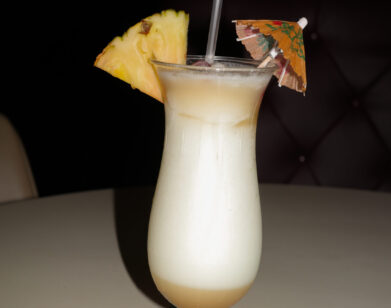How to Ruin Perfectly Good Caviar with Noma’s David Zilber

Jacket and Pants by Lanvin. Shirt David’s own. Sneakers by Balenciaga.
As the director of fermentation at Copenhagen’s trailblazing restaurant Noma, David Zilber is one of the world’s leading experts on the sluggish use of bacteria to transform foodstuffs into bold new ingredients. The Toronto native’s book, The Noma Guide to Fermentation, which he wrote with Noma chef and co-owner René Redzepi, is an obsessive look at the age-old practice that has helped set the Danish food destination apart. There is almost nothing Zilber won’t ferment. Except, that is, for caviar.
———
Step 1
“Get a jar. Fermentation requires a vessel of some sort in which to allow the slow, controlled, enzymatic decay of foodstuffs. This part can be fun, especially if you’re into home decor.”
Step 2
“Get some caviar. People might wonder why you’re letting such an amazing and expensive product rot. But don’t apologize; double down. If you can find albino caviar, which costs about €100,000 per kilo, even better. It’ll communicate that you’ve gravely misunderstood the humble art of fermentation and are capitalizing on its trendiness to overcompensate for other inadequacies in your life. You’ll need one kilo for this recipe.”
Step 3
“Grow koji. We’re going to supplement the enzymes present within the fish eggs with those harvested from moldy grains. Rice koji will have a much cleaner finish than that of barley or wheat, so roll with that. Steam your rice, inoculate it with spores of koji, also known as Aspergillus oryzae, and incubate the bed of grains for 48 hours, at 28°C and 75 percent relative humidity.”
Step 4
“Blend your kilo of caviar with 250 grams of koji, 500 grams of water, and 140 grams of salt. The salt is there to keep it from going off the rails. Caviar is normally salted at a ratio of 3 percent by weight, but given that we’re leaving this bad boy out at room temperature for a full year, we’re going to need extra NaCl to keep the pathogens at bay. A simple hand blender will make quick work of the textural perfection that is caviar from the Caspian Sea.”
Step 5
“Pour the blended, fishy mass into your fermenting vessel, cover it, but not completely airtight, and set it somewhere where it will surely offend the sensibilities of anyone you live with. Find a high-traffic area where the potent scent of autolyzing fish embryos will waft far and wide. Allow it to rest for one year.”
Step 6
“Strain. At this point, the protein-dismantling enzymes will have had time to do their thing, turning long chains of amino acids into the free-floating molecules like monosodium glutamate that your cooking craves. Pour it out into a coffee filter and watch the clear, high-priced juices slowly drip through. Bottle it up and keep it in your cupboard, calling on just a few milliliters to brighten up everything from coconut curry to linguine vongole. Your cooking—and your bank account—will never be the same.”

Sweater, Shirt, Pants, and Sneakers by Balenciaga. Socks Stylist’s own.

Jacket by Ermenegildo Zegna XXX. Vest and Pants by Lanvin. Glasses (worn throughout) and Boots David’s own.
This article appears in the Winter 2019 issue of Interview magazine. Subscribe here.






